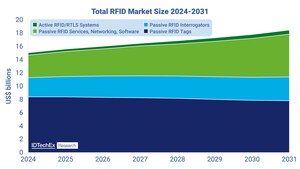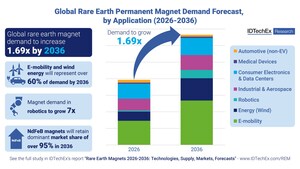
Battery Cell Costs Drop to Almost US$100/kWh, Despite Lithium Price Volatility, finds IDTechEx
BOSTON, Nov. 13, 2025 /PRNewswire/ -- An analysis of Lithium-ion cell prices by IDTechEx concludes that average cell prices have dropped from US$168/kWh in 2022 to just over US$100/kWh in 2025. By 2036, IDTechEx forecasts cell prices could drop to nearly US$50/kWh, based on assessment of material costs and minimal cell prices observed so far, covered in new research on Li-ion Battery Market 2026-2036.
Two chemistries dominate the lithium-ion battery market: lithium nickel manganese cobalt oxides (NMC) and lithium iron phosphate (LFP). NMC offers higher energy density at a higher cost premium, while LFP offers lower costs but lower energy density. Over the last few years, IDTechEx notes the shift from NMC cathodes to LFP in China, Europe and North America, though the latter two regions are still dominated by NMC.
Cathode costs make up a significant proportion of total cell costs, especially for NMC cells. NMC costs are dominated by nickel, lithium, and cobalt. In 2022, lithium supply challenges resulted in significantly inflated lithium prices, increasing the cost of NMC cathode active materials (CAM) by over 80% compared to 2021. LFP saw an even more extreme price inflation, as lithium makes up the majority of LFP cost. However, both cathode prices have dropped significantly since 2022, with NMC 811 cell material costs estimated to have dropped below US$40/kWh as of 2025, and LFP dropping to under US$35/kWh.
Cell material cost breakdown by component. NMC 811 cell material costs < US$40/kWh and LFP < US$35/kWh in 2025. Source: IDTechEx
IDTechEx has also noted a shift towards higher nickel content NMC, such as NMC 9.5.5, which has a nickel content of 90%, compared to 80% for the standard NMC 811. This allows for lower intensities of cobalt, which is a more expensive metal. This difference is especially notable during period of high cobalt prices.
Lithium makes up a significant proportion of cathode active material costs – 84% in the case of LFP and 36% for NMC 811. Lithium prices have historically been highly volatile due to supply chain issues, geopolitical tensions and high capital investment requirements. 2022 saw the highest lithium prices for several years, and massively inflated cell costs as a result. While lithium prices have dropped significantly since then and seem to be trending down, temporary volatility could easily result in massively inflated cell costs and issues with lithium-ion battery supply in the short-, medium-, and long-term. This is further assessed in the IDTechEx report on Critical Battery Materials.
Cell costs vary from industry to industry – in stationary energy storage, where LFP cells dominate, cell costs are more than eight times lower per kWh than for consumer electronics, which require more expensive cathodes and have higher non-active material costs, due to smaller cell sizes.
For deep insight and market intelligence into the global lithium-ion battery market, covering ten-year demand across four major sectors (electric car, other electric vehicle, electronics and stationary energy storage), breaking down the market by both application and lithium-ion battery chemistry, including NMC, LFP, graphite-anode, silicon-anode and more, see IDTechEx's recent report: Li-ion Battery Market 2026-2036: Technologies, Players, Applications, Outlooks and Forecasts.
About IDTechEx
IDTechEx provides trusted independent research on emerging technologies and their markets. Since 1999, we have been helping our clients understand new technologies, their supply chains, market requirements, opportunities and forecasts. For more information, contact [email protected] or visit www.IDTechEx.com.
Media Contact:
Charlotte Martin
01223812300
[email protected]
SOURCE IDTechEx







Share this article